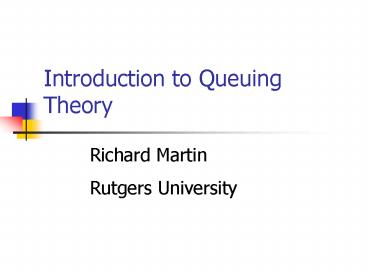Introduction to Queuing Theory - PowerPoint PPT Presentation
1 / 29
Title:
Introduction to Queuing Theory
Description:
View network as collections of queues. FIFO data-structures ... Tautology. Example using Little's law. Observe 120 cars in front of the Lincoln Tunnel ... – PowerPoint PPT presentation
Number of Views:182
Avg rating:3.0/5.0
Title: Introduction to Queuing Theory
1
Introduction to Queuing Theory
Richard Martin Rutgers University
2
Queuing theory
- View network as collections of queues
- FIFO data-structures
- Queuing theory provides probabilistic analysis of
these queues - Examples
- Average length
- Probability queue is at a certain length
- Probability a packet will be lost
3
Littles Law
System
Arrivals
Departures
- Littles Law Mean number tasks in system
arrival rate x mean reponse time - Observed before, Little was first to prove
- Applies to any system in equilibrium, as long as
nothing in black box is creating or destroying
tasks
4
Proving Littles Law
Arrivals
Packet
Departures
1 2 3 4 5 6 7 8
Time
J Shaded area 9 Same in all cases!
5
Definitions
- J Area from previous slide
- N Number of jobs (packets)
- T Total time
- l Average arrival rate
- N/T
- W Average time job is in the system
- J/N
- L Average number of jobs in the system
- J/T
6
Proof Method 1 Definition
Time (T)
7
Proof Method 2 Substitution
Tautology
8
Example using Littles law
- Observe 120 cars in front of the Lincoln Tunnel
- Observe 32 cars/minute depart over a period where
no cars in the tunnel at the start or end (e.g.
security checks) - What is average waiting time before and in the
tunnel?
9
Model Queuing System
Queuing System
Server System
- Use Littles law on complete system and parts to
reason about average time in the queue
10
Kendal Notation
- Six parameters in shorthand
- First three typically used, unless specified
- Arrival Distribution
- Service Distribution
- Number of servers
- Total Capacity (infinite if not specified)
- Population Size (infinite)
- Service Discipline (FCFS/FIFO)
11
Distributions
- M Exponential
- D Deterministic (e.g. fixed constant)
- Ek Erlang with parameter k
- Hk Hyperexponential with param. k
- G General (anything)
- M/M/1 is the simplest realistic queue
12
Kendal Notation Examples
- M/M/1
- Exponential arrivals and service, 1 server,
infinite capacity and population, FCFS (FIFO) - M/M/m
- Same, but M servers
- G/G/3/20/1500/SPF
- General arrival and service distributions, 3
servers, 17 queue slots (20-3), 1500 total jobs,
Shortest Packet First
13
M/M/1 queue model
L
Lq
Wq
W
14
Analysis of M/M/1 queue
- Goal closed form expression of the probability
of the number of jobs in the queue (Pi) given
only l and m
15
Solving queuing systems
- Given
- l Arrival rate of jobs (packets)
- m Service rate of the server (output link)
- Solve
- L average number in queuing system
- Lq ave. number in the queue
- W ave. waiting time in whole system
- Wq ave. waiting time in the queue
- 4 unknowns need 4 equations
16
Solving queuing systems
- 4 unknowns L, Lq W, Wq
- Relationships
- LlW
- LqlW (steady-state argument)
- W Wq (1/m)
- If we know any 1, can find the others
- Finding L is hard or easy depending on the type
of system. In general
17
Equilibrium conditions
l
l
l
l
n1
n
n-1
m
m
m
m
1
2
inflow outflow
1
2
3
stability
18
Solving for P0 and Pn
1
,
,
,
2
,
,
(geometric series)
3
5
4
19
Solving for L
20
Solving W, Wq and Lq
21
Response Time vs. Arrivals
22
Stable Region
linear region
23
Empirical Example
M/M/m system
24
Example
- Measurement of a network gateway
- mean arrival rate (l) 125 Packets/s
- mean response time per packet 2 ms
- Assuming exponential arrivals departures
- What is the service rate, m ?
- What is the gateways utilization?
- What is the probability of n packets in the
gateway? - mean number of packets in the gateway?
- The number of buffers so P(overflow) is lt10-6?
25
Example (cont)
- The service rate, m
- utilization
- P(n) packets in the gateway
26
Example (cont)
- Mean in gateway (L)
- to limit loss probability to less than 1 in a
million
27
Properties of a poisson processes
- poission process exponential distribution
between arrivals/departures/service - Key properties
- memoryless
- Past state does not help predict next arrival
- Closed under
- Addition
- Subtraction
28
Addition and Subtraction
- Merge
- two poisson streams with arrival rates l1 and l2
- new poisson stream l3l1l2
- Probablistic split
- If any given item has a probability P1 of
leaving the stream with rate l1 - l2(1-P1)l1
29
Queuing Networks
l1
l2
l6
l3
l4
l5
l7































